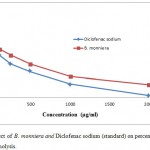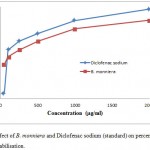Manuscript accepted on : April 22, 2011
Published online on: 28-06-2011
Sharan Suresh Volluri1, Srinivasa Rao Bammidi2, Seema Chaitanya Chippada2 and Meena Vangalapati2
1Department of Biotechnology, DVR and HS MIC College of Technology, Kanchikacherla India.
2Center for Biotechnology, Department of Chemical Engineering, College of Engineering (A), Andhra University, Visakhapatnam - 530 003 India.
ABSTRACT: Bacopa monniera also referred to as Bacopa monnieri, Herpestis monniera, water hyssop, and “Brahmi,” has been used in the Ayurvedic system of medicine for centuries. Phytochemical analysis of B. monniera plant extracts revealed the presence of various biochemical compounds such as alkaloids, flavonoids, glycosides,bacosides, triterpenoids and saponins etc. Since triterpenoids and flavonoids have remarkable anti inflammatory activity, so our present work aims at evaluating the in vitro anti inflammatory activity of B. monniera by HRBC membrane stabilization. The inhibition of hypotonicity induced HRBC membrane lysis was taken as a measure of the anti inflammatory activity. The percentage of membrane stabilisation for methanolic extracts and Diclofenac sodium were done at different concentrations. The maximum percentage of membrane stabilization and hemolysis of B. monniera extracts were found to be 92.92±1.41% and 7.08±1.17% at a dose of 2000 ?g/ml respectively, when compared to standard Diclofenac sodium was found out to be 98.76±1.26% and 1.24±0.87% at a dose of 2000 μg/ml respectively .Therefore, our studies support the isolation and the use of active constituents from B. monniera in treating inflammations.
KEYWORDS: Anti-inflammatory; Bacopa monniera; Diclofenac sodium; Human Red Blood Cell (HRBC)
Download this article as:| Copy the following to cite this article: Volluri S. S, Bammidi S. R, Chippada S. C, Vangalapati M. In Vitro Anti Inflammatory Activity of Methanolic Extract of Bacopa Monniera by HRBC Membrane Stabilisation. Biosci Biotech Res Asia 2011;8(1) |
| Copy the following to cite this URL: Volluri S. S, Bammidi S. R, Chippada S. C, Vangalapati M. In Vitro Anti Inflammatory Activity of Methanolic Extract of Bacopa Monniera by HRBC Membrane Stabilisation. Biosci Biotech Res Asia 2011;8(1). Available from: https://www.biotech-asia.org/?p=9385 |
Introduction
Inflammation is the reaction of living tissues to injury, infection or irritation. Lysosomal enzymes released during inflammation produce a variety of disorders which leads to the tissue injury by damaging the macromolecules and lipid peroxidation of membranes which are assumed to be responsible for certain pathological conditions as heart attacks, septic shocks and rheumatoid arthritis etc. The extra cellular activity of these enzymes is said to be related to acute or chronic inflammation. Stabilization of lysosomal membrane is important in limiting the inflammatory response by inhibiting the release of lysosomal constituents of activated neutrophil such as bactericidal enzymes and proteases, which cause further tissue inflammation and damage upon extra cellular release or by stabilizing the lysosomal membrane1. HRBC or erythrocyte membrane is analogous to the lysosomal membrane2and its stabilization implies that the extract may as well stabilize lysosomal membranes. Stabilization of human red blood cell membrane (HRBC) by hypo tonicity induced membrane lysis can be taken as an in vitro measure of anti inflammatory activity of the drugs or plant extracts.
Bacopamonnieri (Coastal Waterhyssop, Brahmi, Thyme-leafed gratiola,Water hyssop) is a perennial, creeping herb whose habitat includes wetlands and muddy shores3.It commonly grows in marshy areas throughout India, Nepal, Sri Lanka, China,Taiwan, and Vietnam, and is also found in Florida, Hawaii and other southern states of the USA where it can be grown in damp conditions by the pond or bog garden.This plant has a number of uses in Ayurveda. It is a traditional treatment for epilepsyand asthma4.The other reported activities include sedative, antioxidant, vasoconstrictor and anti inflammatory5,6. Phytochemical analysis of B. monnieraplant extracts revealed the presence of various biochemical compounds such as alkaloids,betulic acid, stigmastarol, beta-sitosterol, bacopasaponins, tetracyclictriterpenoidsaponins, hersaponin7,8,9.Since triterpenoids and flavonoids have remarkable anti inflammatory activity, so our present work aims at evaluating the in vitro anti inflammatory activity of B. monnieraby HRBC membrane stabilization.
Materials and Methods
Collection of Plant Material
The fresh whole plant of Bacopamonniera was collected from Araku valley situated near Visakhapatnam, Andhra Pradesh, India.
Chemicals
All chemicals and reagents used were of analytical grade or purest quality.
Extraction and Preparation of methanolic extracts
10 gm of powder of the plant was packed in thimble flask and 250ml of methanol was added in 1 litre round bottom flask. Then the Soxhlet assembly was set up to complete 10 to 15 cycles. The solvent was distilled at lower temperature under reduced pressure, after that the extract was filtered and filtrate was concentrated using water bath to get the crude extract which is stored in freezer for future use. The percentage yield ofmethanolic extract of Bacopamonniera is 15.47 %.
Preparation of Human Red Blood Cells (HRBC) Suspension
Fresh whole human blood was collected and mixed with equal volume of sterilized Alsever solution (2 % dextrose, 0.8 % sodium citrate, 0.05% citric acid and 0.42 % sodium chloride in water). The blood was centrifuged at 3000 rpm for 10 min and packed cells were washed three times with isosaline (0.85%, pH 7.2). The volume of the blood was measured and reconstituted as 10% v/v suspension with isosaline.
Heat Induced Hemolysis
The principle involved here is stabilization of human red blood cell membrane by hypo tonicity induced membrane lysis. The assay mixture contains 1ml phosphate buffer [pH 7.4, 0.15 M], 2 ml hypo saline [0.36 %], 0.5 ml HRBC suspension [10 % v/v] with 0.5 ml of plant extracts and standard drug diclofenac sodium of various concentrations (50, 100, 250, 500, 1000, 2000 μg/ml) and control (distilled water instead of hypo saline to produce 100 % hemolysis) were incubated at 37oC for 30 min and centrifuged respectively. The haemoglobin content in the suspension was estimated using spectrophotometer at 560 nm.
The percentage of hemolysis of HRBC membrane can be calculated as follows: % of Hemolysis= (O.D of Test sample / O.D of Control) X 100
The percentage of HRBC membrane stabilisation can be calculated as follows:
% of Protection = 100 – [(O.D of Test sample / O.D of Control) X 100]
Results and Discussions
The inhibition of hypotonicity induced HRBC membrane lysisi.e., stabilisation of HRBC membrane was taken as a measure of the anti inflammatory activity. The percentage of membrane stabilisation for methanolic extracts of B. monnieraand Diclofenac sodium were done at 50, 100, 250, 500, 1000, 2000 μg/ml.Methanolic extracts of B. monnieraare effective in inhibiting the heat induced hemolysis of HRBC at different concentrations (50‐2000μg/ml) as shown in Table 1. It showed the maximum inhibition 92.92±1.41% at 2000μg/ml respectively, when compared to diclofenac sodium that is 98.76±1.26% at 2000μg/ml respectively. With the increasing concentration the membrane hemolysis is decreased as shown in Figure 1 and membrane stabilisation / protection is increased as shown in Figure 2. Hence anti inflammatory activity of the extracts was concentration dependent.
Table 1: Effect of B. monniera and Diclofenac sodium(standard) on percentage of HRBC membrane hemolysis and membrane stabilization.
| Conc. (μg/ml) | % of Hemolysis
of B. monniera |
% of Stabilisation
of B. monniera |
% of Hemolysisof Diclofenac sodium | %of Stabilisation of Diclofenac sodium |
| 50 | 31.34±1.02 | 68.66±1.13 | 47.18±1.31 | 52.81±1.73 |
| 100 | 27.08±0.78 | 72.92±0.77 | 23.47±0.79 | 76.54±1.12 |
| 250 | 23.46±0.45 | 76.54±1.06 | 18.68±1.65 | 81.32±1.08 |
| 500 | 18.65±1.21 | 81.35±0.86 | 14.34±0.23 | 85.67±0.71 |
| 1000 | 11.76±0.95 | 88.24±0.92 | 7.43±1.11 | 92.58±1.09 |
| 2000 | 7.08±1.17 | 92.92±1.41 | 1.24±0.87 | 98.76±1.26 |
Each value represents means ± SD (n=3).
 |
Figure 1: Effect of B. monniera and Diclofenac sodium(standard)on percentage of HRBC membrane hemolysis.
|
 |
Figure 2: Effect of B. monniera and Diclofenac sodium(standard)on percentage of HRBC membrane stabilisation.
|
Conclusion
Stabilization of the HRBCs membrane by hypo tonicity induced membrane lysiswas studied to establish the mechanism of anti‐inflammatory action of B. monnieraTherefore; our present in vitro studies on B. monnieraextracts demonstrate the depression of inflammation. Due to the presence of active principles such as flavonoids, bacosaponins, tritrepenoidsand related polyphenols may be responsible for this activity. Hence, B. monnieracan be used as a potent anti inflammatory agent.
References
- RajendranVadivu, K. S. Lakshmi., In vitro and in vivo anti inflammatory activity of leaves of Symplocoscochinchinensis(Lour) Moore sspLaurina., Bangladesh J Pharmacol., 3, 121-124 (2008).
- T. Chou., The anti-inflammatory effect of TripterygiumwilfordiiHook F on adjuvant-induced pawedema in rats and inflammatory mediators release.Phytother Res., 11, 152-54 (1997).
- P K; V P K Nambiar, C Ramankutty, V.P.K. &Ramankutty, R Vasudevan Nair., Indian Medicinal Plants: A Compendium of 500 Specie Orient Blackswan. pp. 238(1996).
- Daniel, M. Medicinal plants: chemistry and properties. Science Publishers. pp. 225(2005).
- Rajani, M., et al. “Brahmi (Bacopamonnieri(L.) Pennell) – A MedhyaRasaayana Drug of Ayurveda” in Ramawat, K. G., Ed. Biotechnology of Medicinal Plants: Vitalizer and Therapeutic Enfield, New Hampshire: Science Publishers, Inc(2004).
- Chopra RN, Nayar SL, Chopra IC. Glossary of Indian Medicinal plants, New Delhi, India. National Institute of Science and Communication (CSIR). 32(1986).
- Zhou Y., Shen Y.H., Zhang C., and Zhang W.D., Chemical constituents of Bacopamonnieri, Chem. Nat. Compd., 43, 355-357(2007).
- Yoshiki Y, Okubo K. Active oxygen scavenging activity of DDMP (2,3-dihydro-2, 5-dihydrox n-4-one) saponin in soybean seed. Biosci Biotech Biochem; 59:1556–1557(1995).
- Yoshiki K, Kudou S, Okubo K. Relationship between chemical structures and biological activities of triterpinoidsaponins from soyabean. Biosci Biotech Biochem; 62: 2291-2299(1998).

This work is licensed under a Creative Commons Attribution 4.0 International License.





